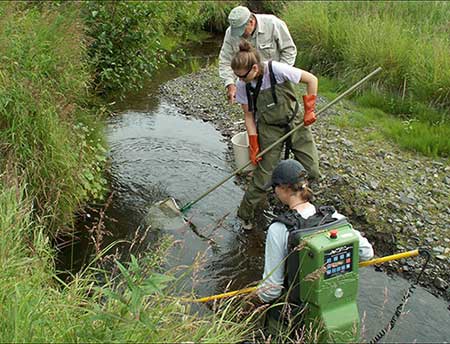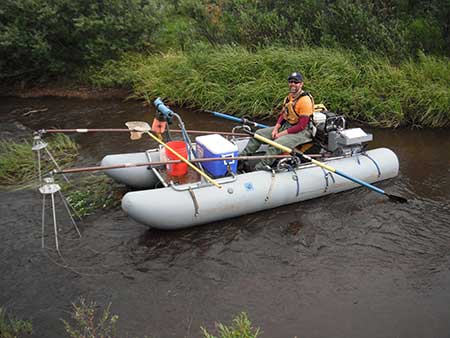Alaska Fish & Wildlife News
August 2015
The Alaska Freshwater Fish Inventory Program

Alaska's abundant, remote, and predominantly pristine freshwater fish habitats are largely unexplored and undocumented. The Alaska Department of Fish and Game’s Alaska Freshwater Fish Inventory program annually designs and conducts studies to try and fill those vast information gaps. The overall goal of the Inventory program is to provide information needed for management of the habitats that support Alaska’s freshwater fish.
The various fish habitat management and protection tools in Alaska are based on our knowledge of the distribution of individual resident and anadromous fish species and life stages. Anadromous fish, for example salmon, are those that hatch in fresh water, then migrate to ocean for the majority of their lives, and ultimately return to the same fresh water body to spawn. Due to the vastness of Alaska's streams and rivers (which total approximately 750,000 miles in length), and more than three million lakes, only a fraction of the actual anadromous fish freshwater habitats have been documented. The department’s Catalog of Waters Important for the Spawning, Rearing, or Migration of Anadromous Fishes (see the June 2015 Alaska Fish and Wildlife News article “Documenting and Protecting Salmon Streams, Anadromous Waters Atlas and Catalog” by J Johnson) currently lists almost 19,000 streams, rivers, or lakes around the state, which have been identified as being important for the spawning, rearing, or migration of anadromous fish. However, based upon thorough surveys of a few drainages it is believed that this number represents less than fifty percent of the streams, rivers, and lakes actually used by anadromous species. An even smaller percentage of resident fish habitats have been documented. Inventorying more freshwater systems will provide better knowledge of fish distribution and habitats important to sustaining wild fish populations.

In an effort to get non-surveyed systems efficiently inventoried, we identify high priority watersheds and study sites using Geographic Information System, or GIS software, and consult with area biologists and resource managers. Following established Freshwater Fish Inventory protocols, three crews, each with two members, simultaneously sample fish communities in selected study stream reaches and lakes in priority watersheds for about three weeks each summer. Target survey sites include wadeable headwater streams, raftable streams, and lakes. Study sites are typically accessed using helicopters, float planes, and jet boats.
Since our main objective entails sampling all fish in a large number of remote streams in a short amount of time, our primary sampling gear is backpack and boat-mounted electrofishers. These units deliver a low level of electrical current to momentarily stun the fish allowing biologists to gather data before returning the fish alive back to the water. With proper training, electrofishing is safe (for both the fish and the researcher) and efficient. In addition to electrofishers, other common sampling gear that we use includes gillnets, minnow traps, seines, dipnets, and angling. We also record aquatic and riparian, or stream-side habitat characteristics at each site.

The Inventory program has a strong history of successfully conducting large scale anadromous cataloging and fish inventory efforts. Following our 2014 field season inventorying Bristol Bay drainages, we submitted Anadromous Waters Catalog nominations documenting the occurrence of anadromous fish at 117 sites in 115 waterbodies. As a result of these nominations, 84 new or extended water bodies were added to the Catalog, resulting in the addition of nearly 500 miles of previously unlisted anadromous fish habitat and six previously unlisted anadromous lakes. Additionally, 50 previously listed water bodies in the Catalog were backed up with additional documentation or new anadromous species or life stages were found. Since 2002, we have conducted similar baseline fish inventories in 42 of Alaska’s 139 hydrologic subbasins.

In 2015, multiple funding sources have been combined to allow us to conduct our fish inventory surveys on the Alaska Peninsula. Funding sources include the Coastal Impact Assistance Program, the Alaska Sustainable Salmon Fund, and the U.S. Fish and Wildlife Service (State Wildlife Grant). These funding sources not only allow us to collect valuable data, but they also help us maintain a database and internet mapping tool for sharing the data.
Fish observation and associated habitat data collected by the Alaska Freshwater Fish Inventory program (and other researchers and projects) is stored in a database available to the public. The easiest place to access this data is via the Department of Fish and Game, Fish Resource Monitor mapping application on the department’s web site. Inventory data is also available upon request by emailing project Habitat Biologist Joe Giefer at joe.giefer@alaska.gov.
The author recently left his Habitat Biologist position with the Alaska Department of Fish and Game to move on to equally green (and perhaps literally greener) pastures sans the beautiful mountains. He enjoyed hunting, fishing, camping, and hiking in Alaska.
Subscribe to be notified about new issues
Receive a monthly notice about new issues and articles.
